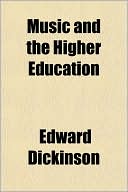

 |

|

The average rating for Music and the Higher Education based on 2 reviews is 3 stars.
Review # 1 was written on 2021-01-13 00:00:00 Amy Tucker Amy TuckerThis book is somewhat useful for self-taught recorder players of age 12 and up. It teaches 16 notes, one at a time, and provides songs that use those notes, in standard notation. It explains time signatures, half notes, quarter notes, eighth notes, rests, dotted quarter notes, and ties, sprinkling these explanations throughout so that there isn't an overload of information. Therefore, it teaches reading music as well. In my experience teaching guitar and piano to adult learners, most will grasp this information on their own from the book. The songs are 1) ones made up to use the concepts just taught, 2) folk songs from three continents, 3) religious (christian) music, and 4) classical music themes. Some songs are modified to make them simpler but they are still recognizable. They're pleasant sounding and appropriate for the recorder. The failing of this book is that all there is. After two paragraphs of introductory text that says to hold the left hand above the right and the recorder at 45 degrees to the body, all explanations stop. In real life, a few problems arise in recorder playing--getting the lowest note solidly and having notes shift octaves on you are the main ones. While slurs are eventually notated here, they aren't explained, nor is any other matter of articulation. Control of breath in sustained notes is crucial to tone for every flute-like instrument, but nothing is said about this, either. No suggestions are made at the end about what sort of music to look for for further playing. (Vocal music is often the best, as its limited to the two-octave range of the recorder.) Were it up to me, I'd divide the book into chapters, introducing two new notes and three or four new notation matters (rests, dotted quarters, etc.) per chapter and also providing a couple paragraphs of explanation about the problems likely to arise. And were it up to me, I'd provide a couple of duets later on in the book. While this is notated for the soprano recorder, one could use it to learn on the alto recorder as a solo player (the music would actually be a fifth lower than the scores here, which any accompanist would have to adjust for). There aren't a lot of book choices out there for self-teaching the instrument. I've found one better internet site, but if you live a low-tech life and want a paper book to teach yourself the instrument, this one will serve. |
Review # 2 was written on 2018-03-19 00:00:00 Jeremy Tollberg Jeremy TollbergAll of Miller's books are, together with a handful of others (Coffin and Vennard) absolute classics of voice pedagogy, and this is no exception. |
CAN'T FIND WHAT YOU'RE LOOKING FOR? CLICK HERE!!!